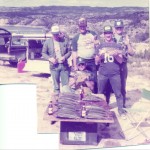By Bob Difley
 Even though GPS navigation is almost as ubiquitous as barbecue grills to RVers, there are some things that a GPS can’t do that maps can. Granted, it’s simpler to follow the directions from a GPS mapping device like Tom Tom or Garmin, especially when delivered by a person with a sensuous soothing voice, when navigating through unfamiliar terrain.
Even though GPS navigation is almost as ubiquitous as barbecue grills to RVers, there are some things that a GPS can’t do that maps can. Granted, it’s simpler to follow the directions from a GPS mapping device like Tom Tom or Garmin, especially when delivered by a person with a sensuous soothing voice, when navigating through unfamiliar terrain.
However, when you’re looking at the big picture, trying to find a route over two-lane roads rather than high speed interstates, looking for public lands–national forests and BLM land–for boondocking and exploring, nothing beats a map from the Forest Service (FS) or US Geological Survey (USGS).
A good place to start for summer camping is downloading “A Guide to your National Forests” map from the FS Web site. This 5 mb PDF file shows color shading (green for forests, yellow for grasslands) for all the FS managed lands. With this country-wide map you can plot a general trip route to pass through forest land enroute to your destination.
Once you’ve designated a general route, go to the “Find National Forests and Grasslands” page and click in the general area of the forest(s) that you will pass through, which will zoom in to an expanded view that identifies the name of the forest. Click on the forest and it will link to that forest’s Web page where you can find the location of the forest office (where you can purchase that forest’s paper map to locate FS roads and campgrounds), notices and information, road closures, wild fire information, recreational opportunities, campgrounds, etc. In the National Forest store you can purchase maps and have them mailed to you.
With all this information in hand (or rather on screen) you may be able to plan your trip using mostly boondocking campsites and low priced forest service campgrounds, which will save you money on the road that you can stuff into your piggy bank for a rainy day–as well as enjoy spending many nights under the trees or in a wildflower meadow instead of a crowded noisy campground.
For more information on boondocking and saving money on the road, check out my ebooks BONDOCKING: Finding the Perfect Campsite on America’s Public Lands and 111 Ways to Get the Biggest Bang for your RV Lifestyle Dollar

Bob Difley
I agree with David, the Apache-Sitgreaves forest is a little known and fantastic high altitude forest is worth going out of the way to visit. Also lots of Native American sites as well as wildlife. Thanks for mentioning, David.
David Rohlader
The Apache-Sitgreaves forest which includes the White Mountains of east central Arizona contains elevations from 7000 to 10000 feet and is cool and breezy during summer, with large lakes for fishing and miles of hiking and ATV trails. Keep in mind that the air is thin at altitude and may affect blood pressure. Watch for coyote, bear, elk, pronghorn, mule deer, Mexican Grey wolf and the occasional puma, (which you may hear, but not see, except at very long range). Follow Rt. 191 or 180 south from Interstate 40 toward the town of Springerville, and stop in at the FS offices on Mountain Avenue.
butterbean carpenter
Howdy Bob,
WHAT THE HECK IS THAT IN THE BACK OF YOUR TRUCK???????
butterbean